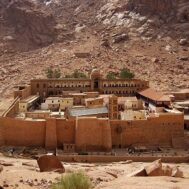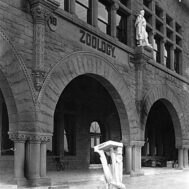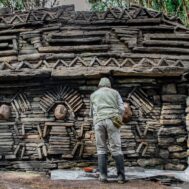President Abdel Fattah al-Sisi of Egypt often appears intent on echoing pre-Islamic Pharaonic greatness – not least by embarking on grandiose building projects to immortalize his rule. Sisi has burdened his country with billions in foreign debt for projects such as the over $1 billion Grand Egyptian Museum. His most expensive project by far is the building of a new Egyptian capital, halfway to Suez in the desert outside of Cairo. Sisi’s New Administrative Capital, with a crystal pyramid and grand palace, is designed to house 6-7 million residents at a cost of almost $60 billion– although the poor and even most middle-class Egyptians won’t be able to afford to live there.
These dazzling monuments to Sisi’s authoritarian regime are being completed despite increasing concerns that Egypt can never pay for them, even by using the military to construct many of the projects. The middle class is already suffering financially through higher taxes and reductions in social services. And Sisi’s grandiose projects are worse than useless to Cairo’s poor.
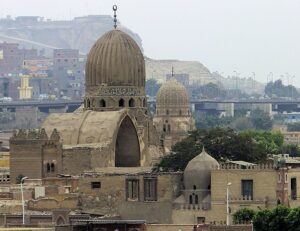
The Mausoleum and Khanqah of Khawand Tughay (or Umm Anuk), the wife of al-Nasir Muhammad, built before 1348 in the Northern Cemetery, Photo by Robert Prazeres, 16 October 2012, CCA-SA 4.0 International license.
Some of the hardest hit by Sisi’s Cairo 2050 project of modernization are those displaced from their homes through construction of new roads and bridges through the poorest sections of Cairo. Highway and bridge construction has also come at the cost of destroying historical and architectural riches in areas such as Heliopolis, spanning the medieval period to the 19th century.
Multiple highways, which archaeologists and UNESCO worry threaten the pyramids, have been built since 2020 across the plains, passing close to the Great Pyramids at Giza, The Step Pyramid of Saqqara and Bent Pyramid at Dashur, bringing tourists to the sites at speed. The two highways, each eight lanes wide, cross ancient Memphis. According to some Egyptologists, they pave over sites and open closed areas to potential looting. A shocked Egyptian former UNESCO official who led a successful campaign 25 years ago to halt construction of similar highways told Reuters in 2020 that all his work to preserve the area was being overturned.
Other arterial roads are being bulldozed through Cairo’s historic neighborhoods, including its City of the Dead, to bring commuters 28 miles to Sisi’s New Administrative Capital. Since the roads that will replace older neighborhoods, parks and cemeteries are of dubious value, many Egyptians feel the destruction is more tied to a wish to remake – or eliminate – Cairo’s history than to fill a transportation need.
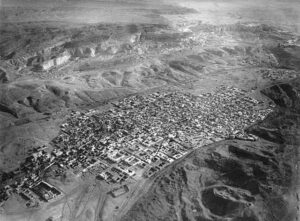
The necropolis (“city of the dead”) where the Sultans are buried at Cairo, Egypt. Photographed from a balloon from about 1200 metres above ground. Photo Eduard Spelterini, January 30, 1904. Public domain.
Cairo’s cemeteries are some of the most extraordinary in the world – containing thousands of historical and architectural treasures. The history of the city can be read in the graves and tombs of the civic and military leaders, sultans and sheikhs, prominent religious and secular figures of all kinds, teachers, writers, poets, legal scholars and historians, calligraphers and artists. Tombs of the Mamluk period (1250-1517) reflected their great interest in architecture and taste for elaborate stucco and carved stone decoration. Tombs of the 18th and 19th C continued to be built with multiple rooms with open spaces and eventually housed generations of the dead.
Cairo’s famous cemeteries have become targets for construction under President Sisi’s rule since 2014. In pursuing his Cairo 2050 project, the President’s office has bypassed the required studies and reviews of strategic city planning normally overseen by development officials and agencies. Instead, concerns are supposed to be heard at the top level of Egypt’s Supreme Council for Urban Planning on which the President, Prime Minister and other top officials sit. After protests against the destruction became more widespread, Sisi said that a committee would be formed of heritage experts, including himself, to modify and improve the current plan. There is no question of updating or restoring existing sites; the dead will either be moved or destroyed. Meanwhile, the demolition has continued, and some members of the ‘expert’ committee have already resigned.
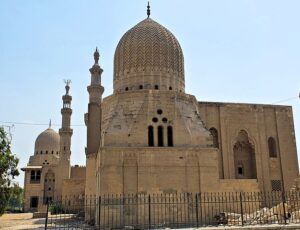
The funerary complex of Sultan Inal, with the complex of Amir Qurqumas visible on the left.Photo Robert Prazeres, 18 June 2019, CCA-Sa 4.0 International license.
Despite the ongoing destruction for new main roads and flyover bridges, President Sisi insists that no harm is being done by the Cairo masterplan for rapid modernization. “We can’t do anything to harm the graves of people we admire or against monumental areas. We build bridges to avoid this… “We should not give an opening to those who want to tarnish our efforts,” he has said.
But Egyptian historians and archaeologists find it easy to cite examples of destruction of cemeteries for recent construction. Government officials denied that a bridge being built through the Mamluk Desert Cemetery in 2020 had affected any but recent tombs but archaeologists disputed the claims that the destroyed tombs were not registered ancient monuments. Archaeologist Hisham Auf pointed out that the cemeteries being demolished to make way for the bridge were in an archaeological site registered since 2009 and held the remains of “pashas, former Egyptian prime ministers, and members of the Egyptian intelligentsia who fought during the Egyptian Revolution of 1919,” saying this cemetery was important to Egyptian history as well.
In an attempt to disarm critics of the cemetery destruction, Sisi announced that a new cemetery called the Al-Khaideen Cemetery (Garden of Immortals) will be established and that ancient tombs would be transferred to it. It’s unknown where this will be and who will be put there.
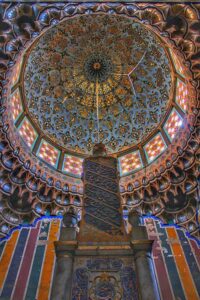
One of the domed tomb chambers in the Hosh al-Basha, the mausoleum (hawsh) of Muhammad Ali’s family, 19th century, Photo by Donia Malak, 1 July 2017, CCA-SA 4.0 International license.
Yet the tombs of key figures in Egyptian history (and world history) have already been demolished. Two examples are the graves of Ibn Khaldun (1332-1406) and Al-Maqrīzī (1364–1442). Ibn Khaldun was a world-renowned philosopher and historian who is considered one of the greatest social scientists of the Middle Ages. Maqrīzī was a medieval Egyptian historian and biographer of both the Fatimid and the Mamluk periods.
The remains of Queen Farida, wife of King Farouk I, were transferred to a mosque when her tomb was destroyed. The tomb of Egypt’s 20th C novelist Taha Hussein, scheduled for demolition, was give a reprieve after protests. Even the remaining tombs near the highway’s path will be isolated and no longer accessible. Galila el-Kadi, an architect who studies ancient cemeteries, says that the government has no understanding of the meaning of heritage or history. She is documenting the City of the Dead and its demolition in order to try and preserve the memory of the destruction.
The government says that registered monuments will be preserved or moved, but the vast majority of monuments that would qualify for registration never have been put on the books. Volunteers comb through the rubble of halfway demolished tombs in search of materials that can be saved. Some, like Dr Mostafa El-Sadek, a professor of medicine, have made extraordinary finds, like a 9th C tombstone for a woman named Umma that had a beautiful Kufic inscription – and which had been later built into a concrete wall.
According to a report from the United Nations Economic and Social Commission for Western Asia (ESCWA), due to Cairo’s extreme population pressure and the lack of affordable housing in the city, many of its cemeteries have been the homes of squatters since the late 19th century. It is estimated that the number of people living in cemeteries reached 1.5 million in 2008 and 2 million in 2017. Cairo’s City of the Dead is the largest and most famous example of this unusual co-habitation of the living and the dead. The traditional construction of the more elaborate tombs was to enclose the actual tomb structure within a walled courtyard and to include a small building that could serve as a guard or caretaker’s shed. These small buildings and shelters were later either appropriated for residences by squatters or actually rented out by the cemetery guards to families who live within and between the tomb complexes.
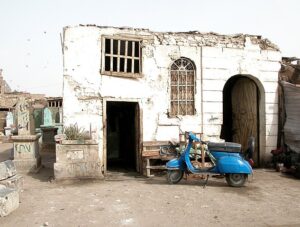
A tomb retrofitted as a residence in the City of the Dead, Cairo, Egypt. Photo by Rgoogin, 19 November 2007, CCA-SA 3.0 Unported license.
Not only the elite historians trying to guard Cairo’s history and the squatters displaced from homes that their families have lived in for generations are angry. Many ordinary folk of Cairo have been forced to either see their ancestors’ graves plowed under or to personally exhume and collect their remains and try to move them. Relatives of the dead gathered in Cairo’s Sayyida Nafia cemetery recently, preparing to exhume their bodies. Traditional Muslim burial is very simple, as the deceased are simply shrouded before burial. A sobbing woman told BBC News that she was there to collect not only her grandparents’ bodies but also that of her mother, who had died just the year before, to place their bodies in sacks and drive them out for reburial in the desert.
Additional reading:
Sisi’s Parade of Absolute Rulers, CPN, 30 May 2021
Egypt’s Brutal Regime Wants to Renew US Blockade on Art; Claims to Protect Heritage & Culture, CPN, 10 March, 2021
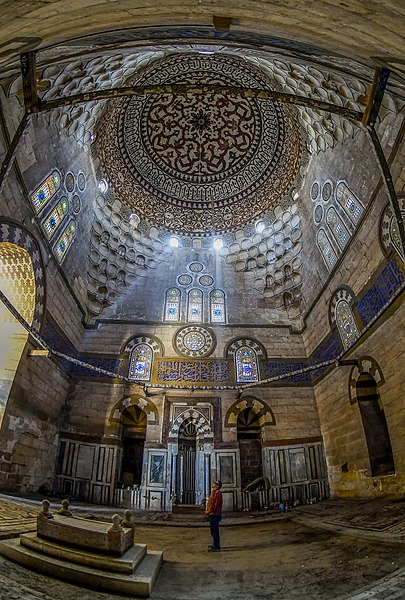 Khanqah of Faraj ibn Barquq (Arabic: خانقاه فرج ابن برقوق) is a religious Islamic funerary complex built by the Mamluk Sultan Faraj ibn Barquq from 1400 to 1411 CE. It is located in Cairo, Egypt, in the Northern Cemetery which is a part of Cairo's historic necropolis districts. The southern mausoleum chamber. Photo by Manadily, 14 April 2018, CCA-SA 3.0 Unported license.
Khanqah of Faraj ibn Barquq (Arabic: خانقاه فرج ابن برقوق) is a religious Islamic funerary complex built by the Mamluk Sultan Faraj ibn Barquq from 1400 to 1411 CE. It is located in Cairo, Egypt, in the Northern Cemetery which is a part of Cairo's historic necropolis districts. The southern mausoleum chamber. Photo by Manadily, 14 April 2018, CCA-SA 3.0 Unported license. 